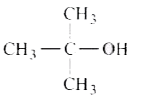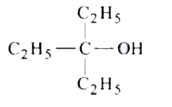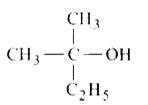One mole of ethly acetate on treatment with an excess of LiAlH4 in dry ether and subsequent acidification produces
1 mol acetic acid + 1 mol ethyl alcohol
1 mol ethyl alcohol + 1 mol methyl alcohol
2 moles of ethyl alcohol
1 mol of 2-butanol .
The correct Answer is:C
To solve the question regarding the reaction of one mole of ethyl acetate with excess lithium aluminum hydride (LiAlH₄) in dry ether followed by acidification, we can break down the process step by step.
1. Identify the Reactants:
- We start with ethyl acetate (C₂H₅COOCH₃), which is an ester.
2. Reaction with LiAlH₄:
- Lithium aluminum hydride (LiAlH₄) is a strong reducing agent. When ethyl acetate is treated with LiAlH₄, it undergoes reduction.
- The carbonyl group (C=O) in the ester is reduced to an alcohol.
3. Reduction Mechanism:
- The LiAlH₄ donates hydride ions (H⁻) to the carbonyl carbon of ethyl acetate, leading to the formation of an intermediate alkoxide.
- The reaction can be represented as:
C2H5COOCH3+LiAlH4→C2H5CH(OH)CH3+LiAlO2
- Here, the ester is converted to a primary alcohol, specifically ethanol (C₂H₅OH) and another alcohol.
4. Acidification:
- After the reduction, the reaction mixture is typically acidified (for example, using dilute hydrochloric acid).
- This step protonates the alkoxide formed during the reduction, yielding the corresponding alcohol.
5. Final Product:
- The final product after the acidification is ethanol (C₂H₅OH).
Conclusion:
Thus, the treatment of one mole of ethyl acetate with excess LiAlH₄ followed by acidification produces ethanol.
Final Answer:
Ethanol (C₂H₅OH)
- We start with ethyl acetate (C₂H₅COOCH₃), which is an ester.
- Lithium aluminum hydride (LiAlH₄) is a strong reducing agent. When ethyl acetate is treated with LiAlH₄, it undergoes reduction.
- The carbonyl group (C=O) in the ester is reduced to an alcohol.
- The LiAlH₄ donates hydride ions (H⁻) to the carbonyl carbon of ethyl acetate, leading to the formation of an intermediate alkoxide.
- The reaction can be represented as:
C2H5COOCH3+LiAlH4→C2H5CH(OH)CH3+LiAlO2
- Here, the ester is converted to a primary alcohol, specifically ethanol (C₂H₅OH) and another alcohol.
- After the reduction, the reaction mixture is typically acidified (for example, using dilute hydrochloric acid).
- This step protonates the alkoxide formed during the reduction, yielding the corresponding alcohol.
- The final product after the acidification is ethanol (C₂H₅OH).
Thus, the treatment of one mole of ethyl acetate with excess LiAlH₄ followed by acidification produces ethanol.
Ethanol (C₂H₅OH)
Topper's Solved these Questions
- ALCOHOLS,PHENOLS AND ETHERSBook:NCERT FINGERTPS ENGLISHChapter:ALCOHOLS,PHENOLS AND ETHERSExercise:HOTS
Explore 7 Videos
- ALCOHOLS,PHENOLS AND ETHERSBook:NCERT FINGERTPS ENGLISHChapter:ALCOHOLS,PHENOLS AND ETHERSExercise:EXEMPLAR PROBLEMS
Explore 14 Videos
- ALDEHYDES, KETONES AND CARBOXYLIC ACIDSBook:NCERT FINGERTPS ENGLISHChapter:ALDEHYDES, KETONES AND CARBOXYLIC ACIDSExercise:Assertion And Reason
Explore 15 Videos
Similar Questions
Knowledge Check
Methyl acetate on treating with excess of C2H5MgBr produces :
A B
B C
C D
D
One mole of calcium phosphide on reaction with excess of water gives
Aone mole of phosphineBtwo moles of phosphoric acidCtwo moles of phosphineDone mole of phosphorus pentoxide.Chlorobenzene on treatment with sodium in dry ether gives diphenyl. The name of the reaction is
AFitting reactionBWurtz-Fitting reactionCSandmeyer reactionDGattermann reaction
One mole of H3PO3 on reaction with excess of NaOH gives :
View Solution(i) An aqueous solution of a compound A is acidic towards litmus and A sublimes at about 300∘C
(ii) A solution of A, on treatment with an excess of NH4SCN, gives a red compound, and on treatment with a solution of K4[Fe(CN)6], gives a blue compound.
(iii) The solid A, on being heated with an excess of K2Cr2O7 in the presence of concentrated H2SO4, evolves deep red vapours of D.
(iv) On passing the vapours of D into a solution of NaOH and then adding the solution of acetic acid and lead acetate, a yellow precipitate of a compound E is obtained.
Q. Can compound A be prepared in the anhydrous form by strongly heating its hydrated crystals?
View SolutionLiAlH4 converts acetic acid into-
View SolutionWhat happens when:
View SolutionOne mole of 1, 2-dibromopropane on treatment with X moles of NaNH2 followed by treatment with thyl bromide gave a pentyne. The value of X is :
View Solution